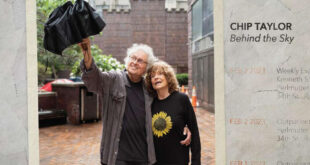
For long-time Janis Joplin fans and aficionados, Amy J. Berg’s recent documentary biography Janis: Little Girl Blue, now available on DVD and Blu-ray, might seem, well, kind of unnecessary. The facts of the blues-rock pioneer’s life are well known, easily learned from written biographies, and colorfully glossed and illuminated by Broadway shows, movies, other films, and memoirs such as Love, Janis by Joplin’s younger sister Laura Joplin, who appears prominently in Janis.
With all that, I still wanted to see it. Something about the intersection of Janis Joplin’s life and music makes her perpetually fascinating.
Janis is not only well made, but welcome for several reasons. First, the Millennial generation should know about the groundbreaking singer’s intertwined life, times, and music. The tragic icon died of a heroin overdose in 1970 at 27 even as she seemed headed up and away from her worst habits.
Maybe it’s a coincidence, but according to Berg’s Wikipedia page, the filmmaker was born in the very month Joplin died – too late to see the singer perform, obviously. I was a bit too late too, so I feel her pain.
An Emmy winner, and an Academy Award nominee for 2006’s Deliver Us From Evil, Berg also received a BAFTA nomination for her documentary West of Memphis about the West Memphis Three. Some critics have said that while West of Memphis wasn’t the first film about that famous failure of justice, it’s the best. Certainly the perspective of hindsight can sharpen rather than blur one’s view of the relatively recent past.
Similarly, Berg’s admiring Janis: Little Girl Blue is clear-eyed. And timely. As Joplin’s contemporaries are aging (indeed, her longtime guitarist and friend Sam Andrew died last year at 73), there’s limited time to gather fresh reminiscences and commentary. For Janis Berg collected interviews with a fair-sized cadre of bandmates and other co-workers, family members, friends, and boyfriends to compile a concise, focused account of the singer’s life and work.
These include the musicians of Big Brother and the Holding Company, the band that made Janis famous, and especially drummer Dave Getz, who offers this: “She was in touch with her own emotions and who she was in some way that nobody else that I knew was…and to be that way, to get there, that’s the price you pay for doing that kind of art on that level.”
One thinks of the famous Neil Young lyric, “It’s better to burn out than to fade away.” The film traces Janis’s desperate pursuit of happiness. A picked-on misfit, she later found satisfaction only on stage, where she’d make love, as she put it, to a thousand people a night – but then go home alone.
We see a few scenes of Janis and fellow musicians hard at work in the studio, and plenty of performance clips, but where the film excels is in showing us how her life fed her performances. For example, boyfriend David Niehaus recounts the happiness the pair briefly found in Brazil, but when he couldn’t abide her heroin use he went off alone to find his own way. Then Berg shows us a clip of Janis’s extended rap to the audience during a subsequent performance of “Cry Baby” in which she addressed exactly that situation – with more bitterness than regret.
Janis Joplin was a tragic figure in the classic sense. Her killer flaw, as Niehaus suggests, was that “she could feel everybody’s pain…she couldn’t block it out.” In clip after clip of her offstage life, a sadness comes through on her face, between the wisecracking and kidding around. It’s impossible to miss.
Archival clips include interviews with Janis that show her struggling to cope with the stratospheric fame she gained after the Monterey Pop festival in 1967. Her friend Dick Cavett was the only media personality with whom she appears comfortable.
Her sister and brother talk of how the young Janis worried about her own desirability and as a result “demanded to be different.”
Bandmates, promoters, and friends recount how after she outgrew Big Brother’s musical limits she struggled to find cohesion and inspiration with new backup musicians, ultimately putting out the masterful album Pearl but not living to enjoy the enormous success of the LP and her biggest hit single, Kris Kristofferson’s “Me and Bobby McGee.”
Out of all this displacement emerged an artistic achievement that continues to inspire performers of all kinds, and not just female rock singers. A few of the latter offer bits of commentary: Melissa Etheridge; Chan Marshall (alias Cat Power), who also reads Janis’s letters with sensitivity; actress-singer Juliette Lewis; and, most relevant for today’s younger viewers, Pink, one of the very few contemporary pop stars who can call to mind Janis’s rocking abandon.
The only DVD extras of note offer more comments from them, and a heartfelt speech by Clive Davis at Janis’s Hollywood Walk of Fame ceremony a couple of years ago. But the meat is in the movie, the best quick filmic introduction to the life and times of a ’60s icon whose star continues to shine. It’s a captivating glimpse into the troubled life of an artist who, however much she came to personify the anything-goes era of the late 1960s, couldn’t fit into the world she was born into and indeed helped to create.
 Blogcritics The critical lens on today's culture & entertainment
Blogcritics The critical lens on today's culture & entertainment



